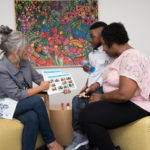What to know about Enterovirus D68

A virus called the Enterovirus D68 (EV-D68) is one to look out for — not just seasonally, but year-round — as it can cause serious health risks to children. EV-D68 is just one strain of Enteroviruses, which cause colds, fever, headaches, vomiting, and rashes among other symptoms. Most Enterovirus infections are very common and spread quickly primarily among children. EV-D68, however, is an unusual strain.
Not only is it much less common than other Enteroviruses, but it can also cause especially bad respiratory illnesses, including a bad cough and difficulty breathing. In some cases, children and other patients with EV-D68 have needed ICU-level care and the assistance of a mechanical ventilator. EV-D68 can be especially dangerous for children with existing lung problems (like asthma) or who have weaker immune systems (like newborns). In 2014, there was a large outbreak of EV-D68 from mid-August 2014 until January 2015. Almost all of the confirmed cases were children — many of whom had asthma or a history of wheezing. This was the first documented nationwide outbreak of the EV-D68, and but as the years have continued on, so has the uptick in infections in children.
Like any other virus, EV-D68 spreads from person to person through bodily fluids — think saliva and nasal mucus — as well as through sneezes, handshakes, changing diapers, and many other kinds of interactions.
Although EV-D68 seems to affect children more than adults, it may be that adults who become infected show much less severe symptoms. There are no vaccines or antiviral therapies for EV-D68 and care is supportive, meaning that all hospitals can do is provide relief for the symptoms. So it’s important that adults who are around children take precautions to minimize the risk of spreading the virus.
Here are some things you can do to help prevent the spread:
- Wash your hands often with soap and water for 20 seconds.
- Avoid touching your eyes, nose, and mouth with unwashed hands.
- Avoid close contact such as kissing, hugging, and sharing cups or eating utensils with people who are sick, and when you are sick.
- Cover your coughs and sneezes with a tissue or your upper shirt sleeve, not your hands.
- Clean and disinfect frequently touched surfaces, such as toys and doorknobs, especially if someone is sick.
- Stay home when you are sick.
- Consider wearing a mask around other people if you have respiratory symptoms.
- Contact a healthcare provider immediately if you or your child has trouble breathing or has a sudden onset of limb weakness.
- Ensure you or your child are following an up-to-date asthma action plan if you or your child have asthma.
- Stay up-to-date with all recommended vaccines.
For more information, please visit the CDC.
Related Posts :
-

Acute flaccid myelitis (AFM): What parents need to know
If you’re a parent, chances are you’ve heard the recent news reports about acute flaccid myelitis, or AFM. ...
-

The mystery of Jane’s left shoulder: Acute flaccid myelitis
When 5-year-old Jane Morehead tumbled off her bike in May 2017, it didn’t seem like a big deal. Jane’s ...
-

What to expect from cold and flu season this year
At least fewer people came down with colds and flu in 2020: That’s one of the few positive things we ...
-

A lifeline for families with asthma
Nilda Gabin knows how terrifying it is to rush to the hospital with a child who is having trouble breathing — ...





